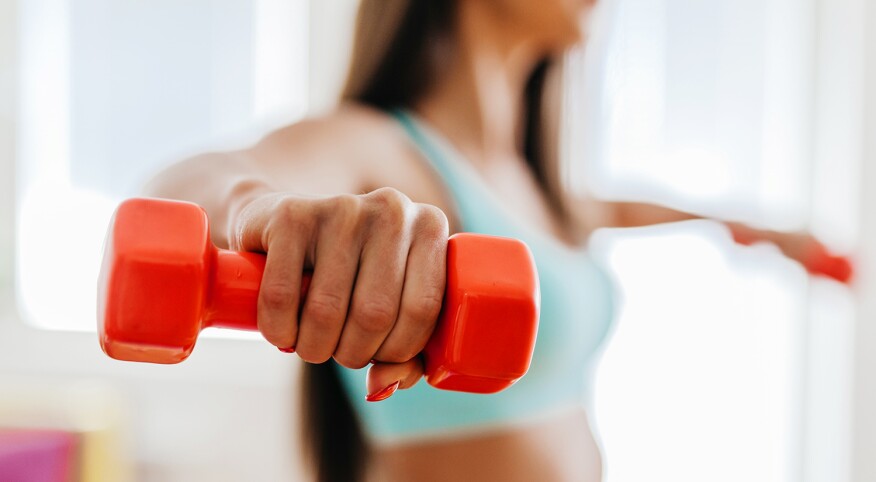Do you love to read? Do you like to win free books? Do you enjoy live interviews with your favorite authors? Then join our fab closed Facebook group, The Girlfriend Book Club, today! We think you'll love it.
Since my inaugural step aerobics class at 15, it’s been drilled into me that exercise is for losing weight, cardio is the best exercise and “nothing tastes better than how skinny feels.”
Thankfully, over the years, the body positivity movement has injected a healing dose of self-love into our body perceptions. Nevertheless, when TikTok’s algorithm started serving me videos of ripped women in the gym performing intense weight-lifting routines, tossing around terms like “push day,” “hypertrophy” and “progressive overload,” my first thought wasn’t, “Wow, that’s great for their physical and mental health!” Instead, it was: “Wow, I want my body to look like that.”
Old habits die hard, and I found myself coveting the toned, lithe physique of these content creators without considering what else I might gain besides muscle.
Following the advice of my favorite fitness creators, I started slowly and listened to my body, alternating push days (shoulder/chest/triceps), pull days (back/biceps) and leg days, with about 15 minutes of cardio per session. I drank protein smoothies and upped my protein intake during meals, patiently awaiting a transformation into a smaller version of myself.
However, surprise! I’m not a 22-year-old fitness influencer whose sole job is maintaining my physique. I’m a middle-aged mom of teens with a full-time job, average genetics and a passion for nachos. So, despite fully committing to weightlifting, shedding pounds didn’t happen. Here’s what did happen instead:
I Got Stronger — A Lot Stronger
Within weeks of adopting my new routine, I noticed daily tasks becoming easier. I could lug more grocery bags per trip. I passed my teenager her backpack without nearly giving myself a hernia. When a roof leak required me to move furniture so the construction crew could make repairs, I was able to hoist my piano out of the way, all on my own. I no longer wake up with back pain.
Alexander Rothstein, coordinator of the Exercise Science Program at New York Institute of Technology, confirms the strength benefits of weight training, particularly for women in middle age and beyond. “[It reduces] the effects of sarcopenia — loss of muscle with age — and stimulates an increase or maintenance of bone density. Both of these are very important as you age.” Muscle strength with a side of increased bone density? I’ll take it.
I Had Way More Fun Than I Expected
The weight-training technique of progressive overload supports gradual increases in weight, repetitions or intensity in order to achieve hypertrophy (muscle growth). After only a few weeks of training, I was able to bump the amount of weight I was lifting across the board. This ongoing challenge has become a huge thrill — I get a kick out of “beating” previous versions of myself. And it’s a point of pride that I can squat more weight than my 18-year-old son.
I Didn’t “Bulk Up”
I know you’re thinking it, But didn’t you bulk up? Nope. But I also didn’t lose weight. Instead, I experienced subtle changes in my shape, like a rounder rear end, shapelier thighs and calves, a more defined waistline, and triceps I can see when I flex — all without sacrificing my love for nachos.
Rothstein notes that it’s common for his female clients to have the unfounded fear of “building too much muscle,” often resulting in using too little weight. “Of course, safety is the most important element,” he says, “but there needs to be heavy enough weight to signal the body that it needs to adapt.” If you aren’t sure where to start, he recommends hiring a personal trainer and telling them you want to learn good exercise form.
I Feel Better Mentally
My workouts have become a bright spot in my day, and on the rare weeks I skip more than two days, I feel it in my mood. My brain feels sluggish, my sleep suffers and I don’t feel my mental best. On the days I work out, my brain feels sharper and more likely to tend toward optimism.
Dr. Ulrick Vieux, Chief of Child and Adolescent Psychiatry at Hackensack University Medical Center, confirms weight training’s mental health benefits, though he stresses it’s not a replacement for therapy or medically supervised treatment. “Weight training two or more days per week has been shown to lead to a decrease in mild to moderate depression and anxiety. It increases the brain-derived neurotrophic factor, which is produced in the hippocampus and has mood-boosting properties.”
The immediate mood boost I get from weight training is tangible, but the benefits to my mental health go beyond that. The gym is my escape, and lifting weights is something just for me. Confidence in my physical abilities translates to more confidence overall. And though I’ve discovered there’s so much more to weight training than I initially thought, I have to admit, it feels pretty great to have my clothes fit better.
How many of you lift weights? How often do you do so? Let us know in the comments below.

Getty Images
Follow Article Topics: Health








